After having personally worked with hundreds of wood species, (obviously some much more than others), and having read a number of books and articles on wood identification, I’ve come to an unsettling conclusion: it seems that the more I learn and discover, the more I realize how very little I know. The more accurate and thorough my identification process becomes, the more certain I become that I really cannot guarantee that I am correct.
Think you’re a know-it-all? Take this test to see how good you really are!
Hypothetical situation:
A wood-collecting friend approaches you with five different wood samples, and asks you to identify them. You ask them where they came from, and they just shrug their shoulders and hand you the samples. You have nothing to go on except the facegrain of the wood itself. This is what you see:
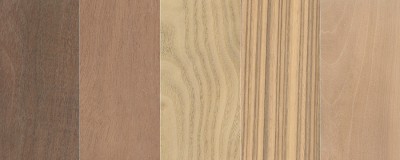
So, what are your guesses? Well, if you had deduced any of the woods that I initially guessed, then you’d get a score of zero! Here are the actual identities of the woods above, from left to right:My Guesses:
- Black walnut – Color and grain look right, and it’s a common hardwood, so it’s a solid guess; weight is a bit high: is this board still drying?
- Honduran mahogany – Grain might be a little plain, but the pattern looks right, and the weight feels close.
- White ash – The color and coarse grain looks like ash, though the weight seems a bit too light: maybe the sample is from a very dry location?
- Zebrawood – What other wood has this kind of zebra striping? Most likely quartersawn since the stripes are so uniform.
- Black cherry – Color and grain are similar, and the weight feels right-on, eliminating heavier fruitwoods like apple.
Do you see how my ability to accurately identify wood based upon intuition was tainted by my own experiences of what I thought were “regular” woods? I named woods that I was used to working with, but for different people, in different parts of the world, this set of intuitive guesses might be totally different. A person in China or Australia might have five totally different guesses than mine, and all could be completely wrong guesses, with each person equally self-assured and unable to sufficiently articulate their position.Correct Answers:
- Black mesquite – A fair amount heavier than walnut, also diffuse porous with vasicentric to aliform parenchyma.
- Andiroba – Well, it’s brown… does that help? There are a bunch of Mahogany lookalikes: it’s not always easy to tell them apart.
- Sassafras – Very similar in appearance to ash, but slightly lighter in weight, and with a spicy odor.
- Beli – Zebrawood isn’t the only wood that is striped. Beli has heavily vasicentric parenchyma, while Zebrawood’s parenchyma tends to be diffuse-in-aggregates.
- Sourwood – Not only was it not Cherry, it wasn’t even in the fruitwood/rose (Rosaceae) family!
The truth is, it’s a crapshoot
Probably the most common means of identifying wood among woodworkers is to simply eyeball the facegrain of the wood sample, and allow some sort of unspoken instinct or imperceptible intuition to just pop into their heads with the right answer. Using this quasi-magic “second-nature” method to accurately identify wood down to a genus and species level is not only unscientific, unhelpful, and unteachable, it’s a crapshoot.
Great expectations
This limitation usually isn’t in the methods or means of identification, but in the wood itself. In botany, a tree species is not classified and described by its wood, but rather, by its leaves, bark, flowers, seeds, fruit, etc. Oftentimes, there are just not enough uniquely identifying characteristics present in the wood of each species to clearly and authoritatively differentiate it from another—not even when viewed under a microscope.
Furthermore, trees occur throughout a variety of natural environments, so the wood exhibits a surprising amount of variability. This is part of what makes woodworking so enjoyable: no two boards are quite the same; but this same variation can also frustrate many identification procedures, and confuse us by the apparent lack of consistency.
The problem is mostly with our expectations: we want to know exactly what kind of wood that we have. We expect just by examining it, that there is some indescribable way of deciphering down to the species level what type of wood is set before us. Sure, we might be able to narrow a sample down to maple, and tell that it is from the Acer genus, but that’s not enough: we want to come up with something like Acer pseudoplatanus. In the majority of cases, that level of precision is just not possible.
But further compounding the problem is that some of the most useful information is contained in a clear and magnified view of the endgrain. Simply viewing the facegrain of a wood sample with the naked eye puts an even greater limitation on our ability to identify it accurately.
One of the worst things that we can do is arrogantly convince ourselves that we can indeed tell one species apart from another when, given the available data, we simply cannot. If we just go by intuition and take an unsubstantiated guess, we’ll quite likely guess wrong.
Fill in the blank, or multiple choice?
Of course, if we had restricted this exercise only to the most commonly used hardwoods, then the identification process would’ve been much easier. But in real-world situations, it’s seldom that simple. It’s one thing to find a misplaced board at a lumberyard and reason, “this must belong in one of these piles” and have our expansive quest reduced to a simple multiple-choice test question.

Or suppose that we were at an Amish furniture shop in Pennsylvania, and we knew that they mill and process all their own timber: the choices would be significantly narrower, and the source of the lumber would be more obvious. We would logically deduce that the wood had to originate from a region nearby, and must be limited to only those trees that are native to the northeastern United States. This is what we call provenance: when we know with a fair degree of certainty where a wood sample came from.
A difficulty for us amateur wood detectives (in addition to the absence of unique identifiers already lacking in the wood itself), is that we usually have little to no information about the origin of the wood. The wood just showed up from somewhere: it was pulled from someone’s dusty garage shelf, or it was taken from an obscure pallet or crate, or it was discovered second-hand at a garage sale. While certain woods are certainly much more common than others, this lack of a reliable source leaves the door wide open to the big, broad, vast expanse of this tree-covered globe. Our number of choices—even among commercially viable timber-producing trees—is staggering, to say the least. We are essentially being asked to fill in the blank. Even a printed volume that encompasses several hundred commercial (and many non-commercial) wood samples would be insufficient to address each and every possible wood species that is and has been in use.
When wood identification works
Of course, there are certainly times when wood identification is very useful and reliable. While there are typically not enough unique characteristics to identify a particular species (i.e., Acer pseudoplatanus), oftentimes—especially with many temperate-zone hardwoods found in the United States—there will be enough information present to reasonably identify a sample down to the genus level (i.e., Acer spp.). We may not be able to take a wood sample and pronounce, “this is Quercus laurifolia—Laurel Oak.” But we should be able to identify that it is in fact an oak, in the Quercus genus. And from there, we may even be able to identify it down to a sub-genus level, and say it is in the red oak group.
But another advantage in wood identification lies in the fact that even though it seems we have no clues to go on, we can usually make some safe assumptions or inferences about a wood sample’s provenance.
For instance, if we see some wooden kitchen cabinets out in a rustic country cabin, it would be reasonable to assume that most cabinet-makers in the area would’ve used a domestic hardwood species. There are only perhaps a few dozen native hardwoods commonly used for cabinetry in the United States, which narrows our options down significantly. In this instance, if we have much experience in domestic hardwoods at all, we should be able to eyeball and/or spot the differences between maple, beech, oak, walnut, etc. relatively easily. (Further examination might then confirm or deny our initial designation.)
But if we were in a fancy, upscale city restaurant where all the woodwork looked foreign and unfamiliar, or we were in a distant locale such as South Africa or Thailand, then the story would be much different, and a much different set of assumptions—perhaps a set unknown to us—would have to be used. (For more information on these types of deductive identification methods, please see the page entitled Wood Identification Guide.)
Be honest
We might as well be honest with ourselves: sometimes wood identification is an uncertain thing. So long as we maintain proper expectations of the identification procedure, and recognize that we might not have all the answers, wood identification can be a useful and enjoyable pursuit. Sometimes the most accurate answer that we can expect to uncover through diligent and thorough examination is simply a question mark.
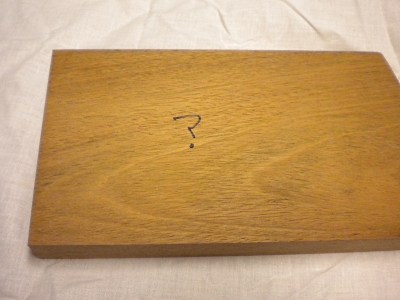
Get the hard copy
 If you’re interested in getting all that makes The Wood Database unique distilled into a single, real-world resource, there’s the book that’s based on the website—the Amazon.com best-seller, WOOD! Identifying and Using Hundreds of Woods Worldwide. It contains many of the most popular articles found on this website, as well as hundreds of wood profiles—laid out with the same clarity and convenience of the website—packaged in a shop-friendly hardcover book.
If you’re interested in getting all that makes The Wood Database unique distilled into a single, real-world resource, there’s the book that’s based on the website—the Amazon.com best-seller, WOOD! Identifying and Using Hundreds of Woods Worldwide. It contains many of the most popular articles found on this website, as well as hundreds of wood profiles—laid out with the same clarity and convenience of the website—packaged in a shop-friendly hardcover book.




Here’s a second pic
Any ideas on this wood type? It’s an old coffin bier. And it appears to have two different woods on it.
Hey Eric can you help me with this one?
It doesn’t look like anything common in North America. Where are you located, and where did the wood come from?
Eric, so glad to have found your site! I’m trying to determine what wood my front door Is. the interior is extremely rough to the touch, must not have ever been sanded, It’s possible it never even had a stain on it either. (1980 home we just purchased). The exterior is extremely weathered. I want to refinish it but would like to know what wood it is first to guide me with what stain I would use. Thank you!
Looks like a type of softwood such as pine or fir.
Sorry if this is a duplicate post, I am trying to attach better resolution pics.
Can you help me to ID the wood that was used for my 1890 Victorian porch floor here in NJ? Contractor was speculating between DougFir and Mahogany. Photos taken from underneath the porch, backside of the painted floor surface. Thanks!
Definitely a softwood like douglas fir (definitely not mahogany). I would say, based solely on your location, it’s more likely to be a species of southern yellow pine. When they are this old, the wood is usually called antique heart pine.
Looks very much like Doug fir. It was being shipped from the West at that time. Heart Pine would be harder and smell very resinous when cut, like turpentine. Red pine is a possibility in NJ but I haven’t seen much of it myself.
Great, thanks, guys, I appreciate it!
Hi Eric,
Thanks for this wonderful database. Look forward to ordering the book once shipping resumes to Australia. Would be able to help me identify this timber?
Thanks and cheers,
Indi
Hard to say from pictures. Looks like a diffuse porous hardwood with small pores. Probably the most common Australian hardwood that fits this description is https://www.wood-database.com/tasmanian-myrtle/
Thanks for article. I’m still struggling to figure out the wood we have on our stair railings. Back story – we decided that refinishing our stairs would be a great DIY project. We pulled up all the carpet, pulled out hundreds of nails and staples and spackled the nail holes on the white risers. Then we started to sand the oak stairs (60 yr old home) and railing. That’s when we started having problems. The curved sections of the spindles and newel post wasn’t easily sanded, even with many tries at it. Therefore, we did a little research and decided… Read more »
First and third pics are beech. Not sure about middle picture as it appears to be stained wood and may not be same material.
Hi, awesome website! Would you be able to explain this lumber stamp in picture #1, they are stamped my sub-floor? Also, based on my second picture for my floor joist, any guess on what species they could be? The floor joists are 2×10, span 18.5 feet plus, built 16″ on center, and constructed in the 1960’s where located in the Northeast USA. Thanks!
Please attach pics
sorry says Not allowed file type: jpg. What formats can I attach here? Thanks!
Not sure what could be wrong, people attach jpg files every day here. Are you sure the files are under 2MB size?
Hi! Can anyone help me identify what type of wood this is? Thanks in advance
Can you sand through the weathered surfaces and repost fresh pics?
Are these any better? Thanks Eric!
Any luck with this Eric? Thanks so much
I can just barely make out what appears to be rays in that last endgrain picture. I’d say it’s probably oak.
Hello,
Can anyone help me identify this wood?
Thanks
Can you post a close up picture of the endgrain, finely sanded to at least 220 grit?
Let me know if these help?
Thanks!
Not sure what happened to your pics, but they have lost a lot of detail.
ok, did you want to see the end of board? What pics can I send?
Primarily the endgrain, but also a close up of the face grain too if possible.
Hope this helps?
More pics:
More pics:
Could it be Brazilian Cherry?
Hello, What happened to this thread?
Sorry, I don’t know why but it appears I am having a lot of issues with image uploads for comments. I guess it’s turning into a deceptively difficult feature to implement well!
Hello Eric,
Any luck with the above pics?
Thanks
Sorry, the wood doesn’t resemble anything immediately recognizable. Can you provide more info such as where in the world are you located, where the wood came from? Also, how heavy is the wood compared to another known wood? Any noticeable scent when working with it?
I am in the mid-west USA. The wood is heavy with no scent.
I’m stumped, sorry. It doesn’t look like Brazilian cherry. It does look like a diffuse porous tropical hardwood, but it can be very hard to ID these woods.
Even histopathologists say “appears”, “shows signs of”, and so on clauses. I wonder if microscopic evaluation combined with 2 other methodologies is the only really reliable way to arrive at the highest probably of “what it is”
I have used this site many times. This is the first time I looked at this quiz.
I only got 1 right… the sassafras.
Hoping to identify my wood flooring. Approx 2in width and 1/4 depth, nailed in. Pictures of top side sanded down and a picture of the back side. Oak Maybe?
looks like oak to me
Oak, probably white. The rays are longer than typically seen in red.
I’ve tried to identify some wood that was given to me by my neighboring golf course. The guys who cut it down thought it was a Sheoak, but going on leaves and bark I though it might be a gum. Now gum or eucalyptus have apparently undergone a name change and are now referred to as Corrymbia. The closed I got to identifying it, according to bark and leaves was Corrymbia Intermedia. Once cut, it was quite heavy in part due to being wet and possibly quite dense too. Colour is off white to cream and a light reddy brown… Read more »
I think we’ve been ripped off, but I don’t know. How can I tell if fence builders really built our fence out of cedar? The material looks like absolute garbage. Super rough like it was cut with a pocket knife. And only 1/2 inch thick. Built a 6 foot fence with this crap. It’s supposed to be cedar. I can put the planks and make them bow with one finger. How do I know what material this is? We paid for a solid cedar fence. Help somebody, please.
Cedar has a distinctive scent. I think the wood in your fence should have that scent.
Not all cedar is aromatic, especially if it’s been out in the weather for a bit.
It’s probably home depot unsanded rough unsanded cedar. Cedar is soft and smells… just… just wonderful.
Here’s a challenge that I inherited from my father’s estate in 1992. My great grandfather, Constantine Thorn, was a carpenter in Phila circa 1880. His hobby was collecting wood. He specifically built this box containing 3008 different types of wood from famous places & items. He diagrammed and listed all the woods he used in this box. I have photos of this box. I have copies of his diagrams of the wood locations in the box. I have a copy of the list of the woods he used in the box. I have 3 letters he wrote detailing information about… Read more »
Sorry can’t help with your identification but would love to know more about this. Do you have a website or page where people can read about this?
My best story about wood identification, which somewhat proves your point, has to do with a pen I saw at the airport in Massachusetts. Now I have lived 40 plus years in Hawaii and started turning pens a number of years ago. In Hawaii, the wood that is most prominent is Koa, the ali’i (royalty) of all woods, and more beautiful than any other species (when talking to a woodworker from Hawaii). I have handle a lot of Koa over the years and know it fairly well. I can spot it and differentiate from Australian Blackwood, which looks pretty similar.… Read more »
In searching th would seem that as the bark of the tree that produces commercial cinnamon it what is used the wood should be abundant and very nice. I had a stick from a dead branch that was still fragrent after several yesrs. As it is extensively farmed the wood aught to be available. Is it perhaps a different bame?
Looks like cinnamon primarily comes from the tree Cinnamomum verum. I’ve never seen this wood before, but a related species would be Camphor, known botanically as Cinnamomum camphora. https://www.wood-database.com/camphor/
Thanks Eric
I work with wood 2 years, but i still confused mahogany from south africa and south east asia
Eric, Thank you for this site, its marvelous fun. What’s the ubiquitous wood used for cheap dowels? Pale yellow through greenish, to pale gray/white. Google searches suggest “poplar” but I believe it is something else, from South East Asian / Pacific island jungle? It has little visible grain, splinters easily (when sawn or bent to failure) and seems simply the cheapest possible material that can be shaped to that form. I always knew closet bars were oak, it took me an embarrassingly long time to find smaller oak, etc., dowels for filling stripped screw holes in good wood or where… Read more »
I believe that you are confounding two species: ramin (from SE Asia) and yellow poplar (US native). In the past, lots of dowels were made from ramin, but it’s been heavily exploited and it’s now considered an endangered species. Nowadays, at your typical big box hardware store such as Home Depot, Menards or Lowes, you are VERY likely to find dowels made of yellow poplar.
Thank you! I’d seen that Ramin was endangered, and couldn’t remember if I’d seen the characteristic blue fungus on dowels. Foolishly presumed that wasn’t it. If I buy more, I’ll hope they’re Yellow Poplar.
Unrelated but fun: A neat way to identify Red Oak is that the dried wood has open pores that run parallel to the grain. You can suck air through the grain, as were, but not across the grain. True of other Oaks?
That’s likely true of at least a few other oaks, maybe even most of them, but not white oak. There are a ton of oak species, though, so it would be impossible to say definitively whether that would be true for “other oaks” without specifying on a species by species basis.
I guess you are a expert now Wood Data Base and a great infomation douse you are the best on the internet if the truth was known, So i guess you just keep a dictionary of all the simular wood samples just 30 case one looks the same as the other wood specie, and I am sure you do this and know, how else could you not have known? Since you just told us so we conclude you are a expert and know what you are doing, and the more you know the less is untrue, i guess it’s labour… Read more »
Technically, the common name “black walnut” refers to the America species Juglans nigra, at least it does over here in the US. Though it may be Juglans regia, which is sometimes just called “walnut” or common walnut over in Europe. Pictures would help to give a more definitive answer.
More images of the same piece.
Back: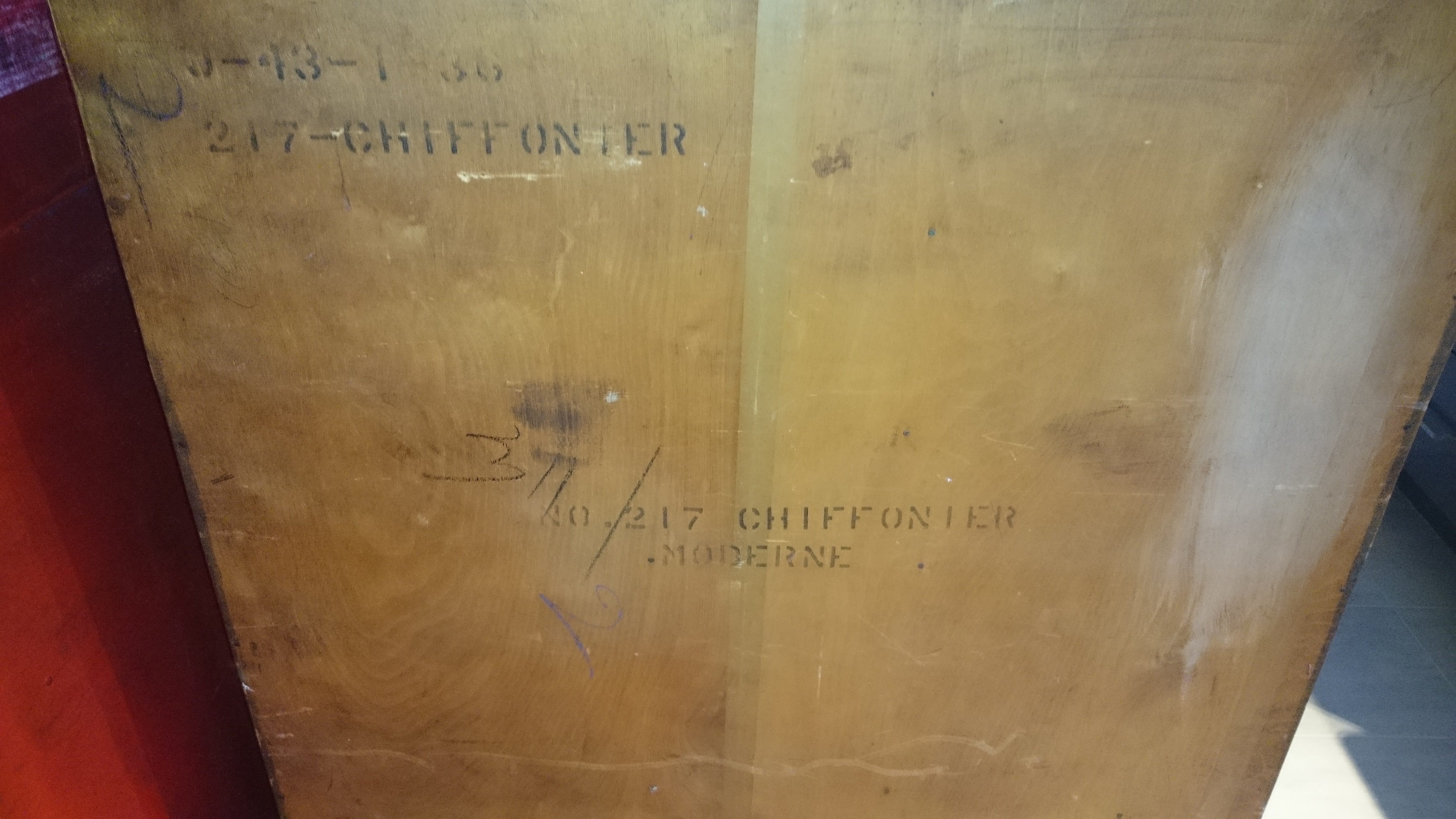
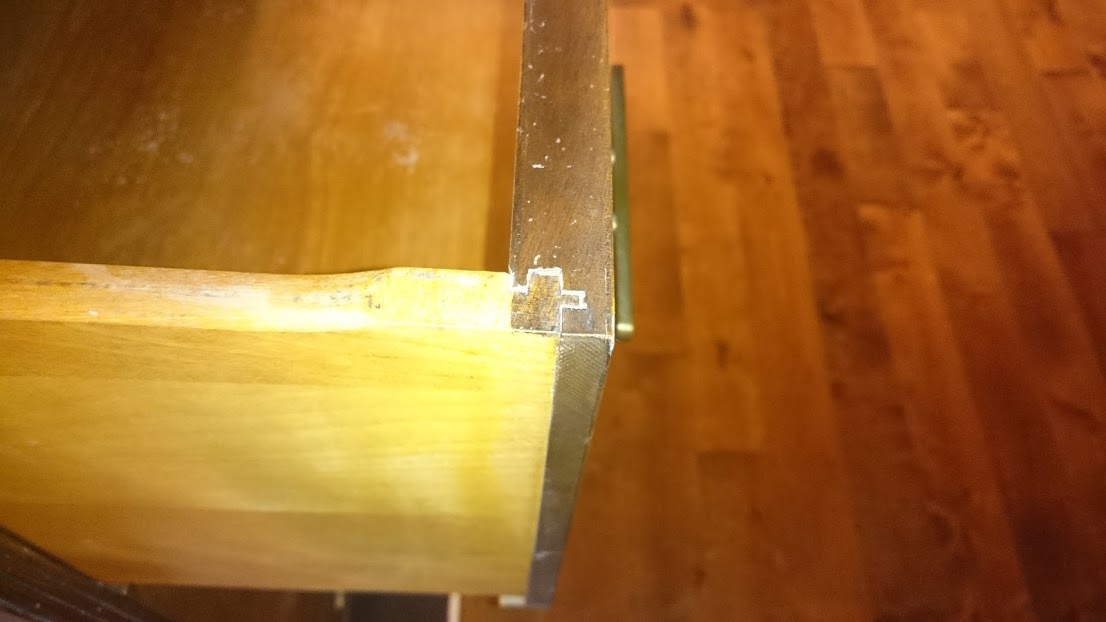
Dovetail detail on drawers:
I’m hoping for an identification of the wood used in this furniture piece. It’s a few years old, had belonged to my grandparents for many years.
The drawer/door fronts are, I’m sure, veneered.
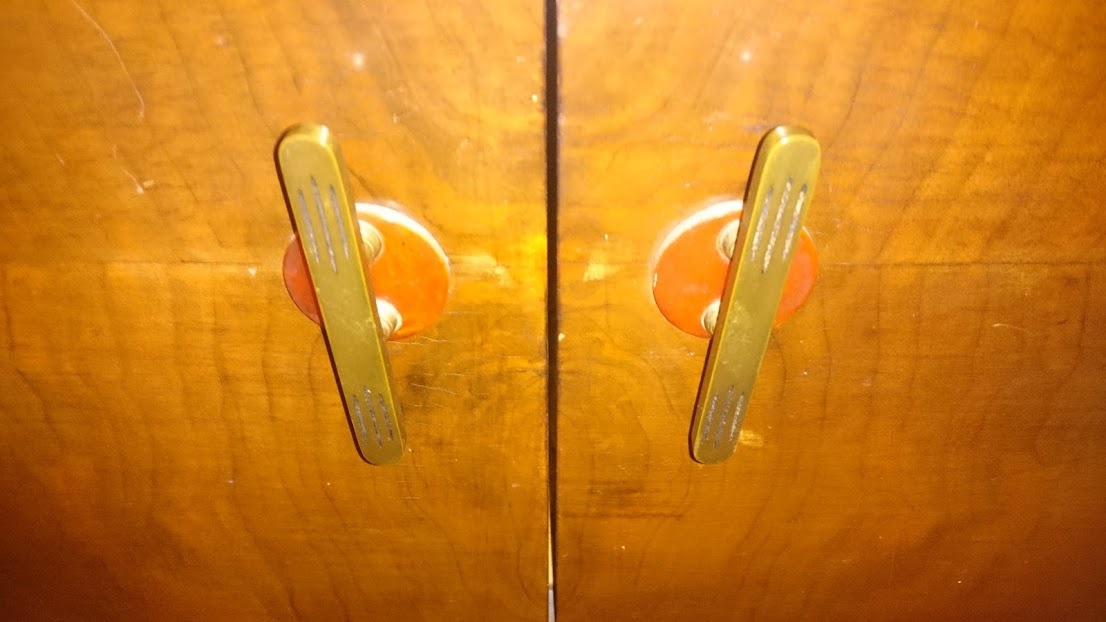
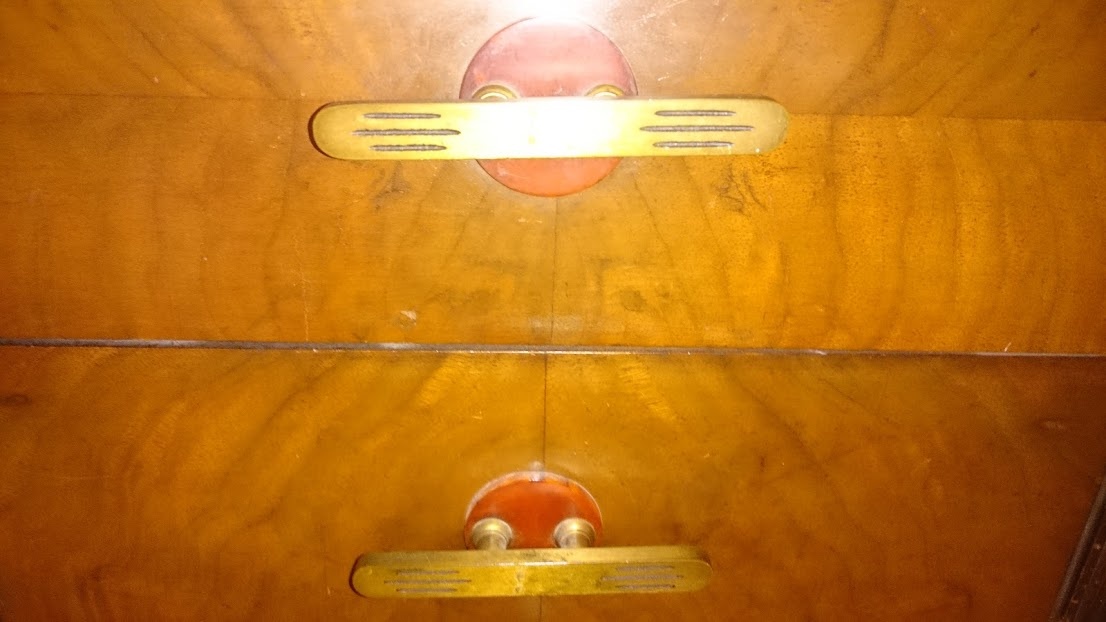
Hello, if i send u a few pic of a piece of wood would you kindly assist me in identifying it?
I can certainly try.
I am trying to identify what kind of hardwood floor is hiding under my laminate flooring. The house was built in 2001. Can you help me?
Thank you for this article. You have saved me the next couple of hours trying to educate myself online before buying an antique dresser for a repurpose project that I have in mind. My criteria will now be: “Do I like the piece and is the price reasonable for the end product?”. Okay, now, it’s onto other things that I need to get done.
I could swear the first one was Ipe
I work in a microscopy lab where we often have to ID fragments of wood. We use a cryostat and compound light microscopes that magnify up about x1000. We can usually only ID down to genus level. As was said above there is just too much variation in organic tissue. I can say now that UV spectrometry isn’t going to help you. It will tell you that you have cellulose, but that’s probably about all. As for the DNA testing thing. I can’t see that happening any time soon. As it is extracting DNA from tough relatively dry tissues like… Read more »
I agree It’s the Janka hardness (quality of the wood ) that matters, not the spicie, so like you said it’s just plain old cellulose, It does not matter if you canot identified the wood ,mats it’s quality that important, Wood is only worth truly identifying in forensic as evidence, This is simple now days, So to identified a specie to with a sample using technologys of a lab is imposible becsuse the science is needed is forensic i guess,
Does wood contain DNA or just RNA?
The Periodic Table is definitely available: there’s a link to buy on in the upper right of every page. The wood BOOK is what is not currently available. That’s still a work in progress as of Feb. 2014.
It would help if you knew where the wood originated, country, region, state, province, etc.
BOY!! Do I feel dumb. I.D.on the woods above i failed miserably. And I been working with wood for at least 55yrs. I bought a box of wood at the flea market.Its dark and heavy for its size. Its look like purple walnut or mahogany. But now i’m scared to guess after this.Its cut into blocks.1″x1″x 9″lengths Maybe brazilian rosewood?. This is why and how I ended up on this site.Trying to get answers. ANYBODY!!! HELP!! Thanks
Hi Woodlovers – I came upon some “trash” wood with wheels attached (not sure what it once was) in a dumpster, but the wood seemed in great shape with some good character beneath. When I got it home and sanded it down, I was AMAZED at the figuring on these boards. Problem is I can’t for the life of me figure out what species of wood this is. I welcome any guesses. It’s relatively hard, but not too heavy. Any suggestions or follow-up questions are greatly appreciated. Nice looking grain though, eh? I’m thinking tabletop, I have about 8 pieces.
I would bet the wood is doug fir in that silver mine.
Siding
My father left me a silver mill that was constructed in 1893. It is 30,000 square feet, has withstood 120 years of harsh Nevada weather because it has beautiful 1X12X16′ siding, 8X10X20′ truss beams and 20X22X14′ posts. The mill sits in central Nevada… do you think the wood would be Doug fir, Pine or some other species?
And a side view
Here a picture concerning my previous comment.
What are the mechanics of why a particular species is preferred for stringed instruments? Is it the hardness are perhaps its ability to absorb or counterflect vibrational energy? What I do know is that the sustainable vibration of the string is most prized. But what is it that wood does to make this happen?
20 year ago I have made a table taking wood from a crate coming from Mexico. The wood was a red soft wood. I need to make a repair and a mod on this table but for that I will To use the same wood! The color of that wood was very varied from yellow to red turning more brown when coming older. The density dry is 550 kg/m3. Can you help me?
I also have some of the wood that was cut into firewood :(. Someone suggested Red Elm, but I am not sure.
Thanks for this very interesting article. I will share this anecdote with you : my wife and I used to walk in the nearby forests, where lots of beech trees grow (south of Paris, France). But at first, we didn’t know their name and as those trees where everywhere, we needed one to differentiate them from oaks and birches. So we decided to call them “elephant trees” because the color, texture and majestic size of the trees reminded us of elephants trunks. Obviously, we knew this wasn’t the right name, but even now we still call them “elephant trees” when… Read more »
I want to make a marquetry but i dont know which veneers are used. please tell which 3 veneers are used in this picture
if you know any other good combination of veneers please tell. thank you
Jeff, If aesthetics were the only criterion, you’d be right; and perhaps in your situation, it really doesn’t matter what wood species you use, so long as the look is right. However, wood is more than “a pretty face,” so to speak. In the hypothetical example above, if you had flooring that was Black Walnut instead of Black Mesquite, it’d be about half as hard on the Janka scale, and wouldn’t wear nearly as well. Or if you’d used Andiroba instead of true Mahogany, it wouldn’t be as stable, with more movement in service. And Sassafras instead of Ash for… Read more »
Pretty. Or “cool.” Or some other similar descriptive– in the end, it’s all just wood, and bookmatching something built yesterday is impossible today. I understand our need to categorize and classify, but in the end, if it catches the eye, who cares what its “real” name is? I don’t. Guess that’s one of the reasons I couldn’t stand biology and ended up a chemE. As you describe for a pitfall in your “name that wood” game, I guessed exactly the same as you did. Of interest is the non-zebra-zebrawood. To me, its “striped” wood, and I happen to have a… Read more »
If aesthetics were the only criterion, you’d be right; and perhaps in your situation, it really doesn’t matter what wood species you use, so long as the look is right. However, wood is more than “a pretty face,” so to speak. In the hypothetical example above, if you had flooring that was Black Walnut instead of Black Mesquite, it’d be about half as hard on the Janka scale, and wouldn’t wear nearly as well. Or if you’d used Andiroba instead of true Mahogany, it wouldn’t be as stable, with more movement in service. And Sassafras instead of Ash for a… Read more »
Exactly. Also the type of wood matters in at least a few other ways. When it comes to finishing (if pores are open or not), to toxicity (if you need a dust mask), drying (to calibrate the moisture meter), processing (angle of cut to avoid chipping and power of motor), etc
Maybe someday there will be cheap and simple to use DNA wood identifying tools. Or maybe not.
You also have to consider accuracy when selling a project. You wouldn’t want to sell a chair made of pine, claiming it’s oak. A carpenter’s reputation is on the line. A buyer will pay more for an oak chair vs. one made of pine, and would be very upset (rightfully so) to find they paid oak prices for pine.
How about DURABILITY? I certainly would not want to make a beautiful piece of furniture out of Basswood or Balsa wood. I carve bass wood and finish it to look like hardwood but it hangs on the wall for decorative art.
Happy to have found your site.. I am new to furniture refinishing and recently started a project to strip black paint/stain from a buffet that belongs to my Grandmother. I was surprised to find an inlay (?) on the drawer. I have not gone any further and wonder what kind of wood it may be ? So appreciative to any help anyone can offer ..
Hi All, I guess the only surefire way in the coming future will be DNA testing. As the cost of DNA testing is falling it will increasingly be more viable financially. Who knows in a few decades cheap testing devices connected to the internet might exist? That said, a comprehensive database still needs to be developed which is expensive and the current one is limited to a few trees. It is estimated it would cost a million Dollars to map all the Teak species but I guess costs will come down eventually. Ironic to think that all living species are… Read more »
Well I doubt DNA will one day be usefull for identification for woodworker, as DNA extraction from wood is difficult and not cheap vs animal or green plant part extraction … but wood anatomy is quite reliable in identification (see Schweingruber microscopic wood anatomy web site and book). The only difficulties is you need a microscope, and the best way is to make charcoals an use a microscope with reflective light and and polarizer (if interested I should have some pic in an old cd from my master). But in all cases, DAN or microscope you need to know in… Read more »
I’m sure that we will see cheap, disposable DNA tests in a while that can identify a whole range of woods with a single test. Or a small tablet with a DNA chip that can do the identification from a bit of wood dust scraped of the wood, that can be reused over and over again. Or a tablet with a camera that can view UV, visible and/or (near)infrared light and maybe a laser or lasers and/or prism(s) that use spectrography or something like that to identify wood species. Identification should get easier in the future though. For example the… Read more »
How about using specific weight, and tensile strength test or standardized hardness indentation test? ^_^
Tom, if the wood’s really as soft and light as you’re describing, then my best guess would be that it is Redwood.
I removed some decorative beams and shelves from my Michigan home that was built in 1963. The wood is a dark brown with a faint red hue. It’s very light and soft as pine. They used quite a bit of the wood in the house and garage for shelves and trim. The house is modest and of average construction so I doubt the wood was very expensive for the period. Any idea what type of wood it might be?
Luke, you’ve hit on a specific subject that I’m really trying hard to focus on in the upcoming month or so: separating between two species of wood that are often confused. (I’ve already got one on red vs white oak, but I want to expand this into a series of articles to include exotic species, etc.) Right now, I don’t have an endgrain zoom scan of EIR up, but to be brief, BR tends to have fewer pores per square inch than EIR (about half as many). Also, if take some shavings (as off a handplane) and mix them in… Read more »
Hello,
I recently had some Guitar Brazilian Rosewood cut I’ve been saving over 30+ yearsI thought was Brazilian, but now am suspect it is East Indian. Brazilian always smells “Rosey” to me & with different color mostly Reddish Brown & other physical characteristics, and E.I. Rosewood has always had a less pleasant smell more purple colors.
Any help with added ID?
thanx
Luke
Luke, you’ve hit on a specific subject that I’m really trying hard to focus on in the upcoming month or so: separating between two species of wood that are often confused. (I’ve already got one on red vs white oak, but I want to expand this into a series of articles to include exotic species, etc.) Right now, I don’t have an endgrain zoom scan of EIR up, but to be brief, BR tends to have fewer pores per square inch than EIR (about half as many). Also, if take some shavings (as off a handplane) and mix them in… Read more »